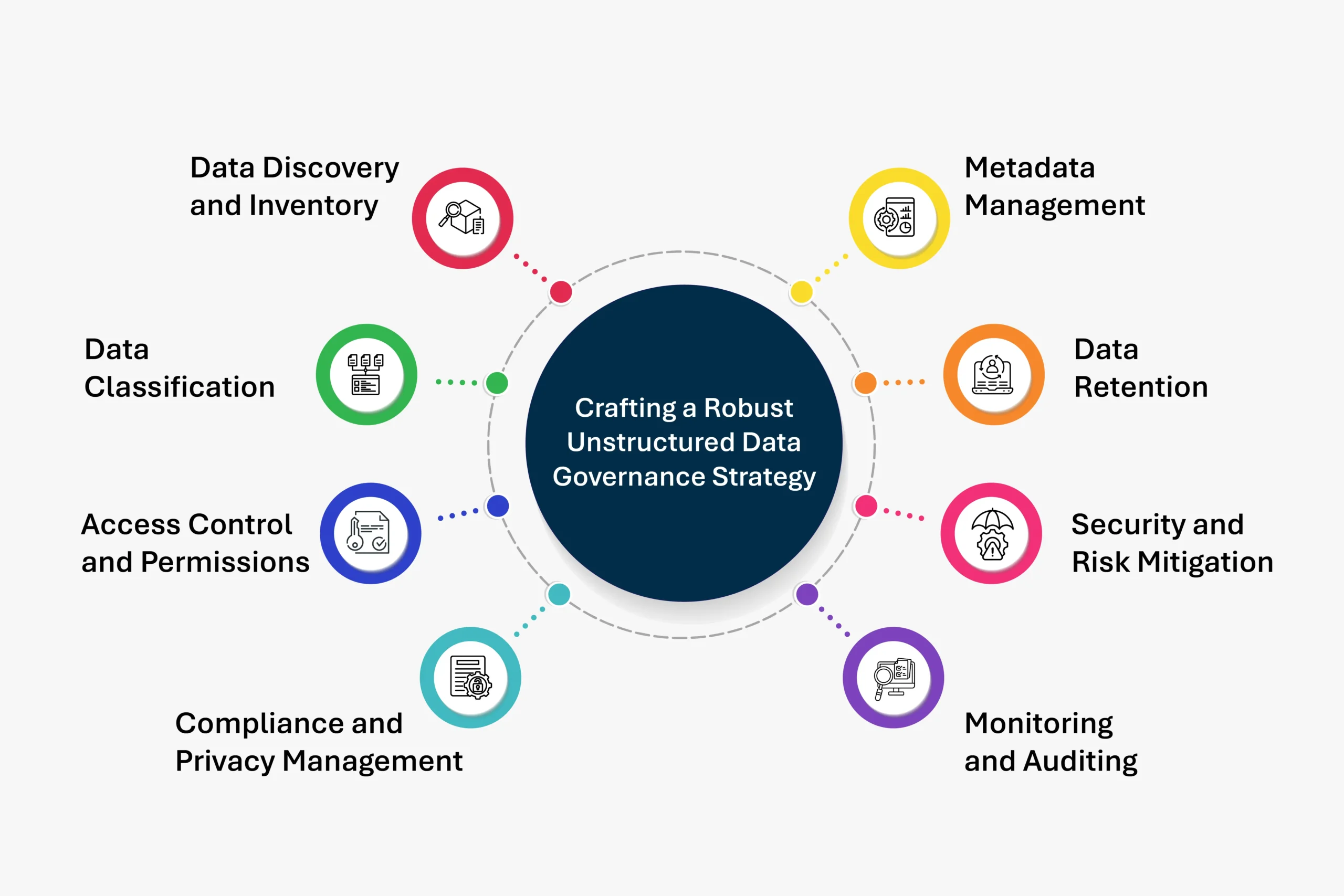In a world where unstructured data makes up the majority of organizational information—spanning emails, videos, images, and more—managing it effectively has become a critical challenge. Without proper governance, this sprawling data landscape can lead to inefficiency, compliance risks, and missed opportunities. Unstructured data governance provides the framework to manage, secure, and utilize this data, ensuring it aligns with privacy regulations and organizational objectives. By transforming chaos into clarity, it turns unstructured data from a liability into a valuable business asset.
What is Unstructured Data Governance?
Unstructured Data Governance refers to the set of policies, processes, and technologies designed to manage, control, and secure unstructured data, ensuring it is utilized effectively while adhering to compliance, privacy, and security standards. Unstructured data includes all data that does not follow a predefined model or structure, such as emails, videos, images, PDFs, audio files, and documents. This type of data often makes up the majority of an organization’s data assets but is harder to organize and analyze due to its lack of structure.
Crafting a Robust Unstructured Data Governance Strategy
A robust unstructured data governance strategy consists of several key components that ensure the effective management, security, and utilization of unstructured data while aligning with organizational objectives and regulatory requirements.

1. Data Discovery and Inventory
Unstructured data is notoriously elusive, often scattered across cloud environments, shared drives, and personal devices. Effective governance starts with data discovery—the process of identifying where data resides, how it flows, and what risks it carries. Leveraging automated tools, organizations can uncover hidden pockets of data, classify it by relevance, and build an inventory to visualize their data landscape. This foundational step reduces redundancies and lays the groundwork for efficient governance.
2. Data Classification
Unstructured data can harbor sensitive information buried in complex formats, making data classification critical. Advanced technologies like AI and machine learning help organizations categorize data based on content and context, identifying high-value or high-risk assets. For example, emails containing customer information or videos with intellectual property can be tagged as sensitive. By prioritizing these datasets, enterprises ensure compliance, streamline operations and secure their most valuable assets.
3. Access Control and Permissions
Without inherent permission structures, unstructured data is vulnerable to unauthorized access. Implementing role-based access control (RBAC) and enforcing the principle of least privilege ensures employees access only the data they need. Regular permission audits further bolster security by identifying overprovisioned accounts and mitigating risks of data misuse. These measures not only enhance security but also maintain operational efficiency.
4. Compliance and Privacy Management
Unstructured data often contains sensitive customer and employee information, making compliance a top priority. Embedding regulations like GDPR, HIPAA, or CCPA into governance frameworks ensures legal alignment and fosters trust. Tools that flag non-compliant data in real-time and technologies like encryption, data masking, and pseudonymization protect sensitive information even in the event of a breach. This proactive approach goes beyond meeting legal requirements—it positions organizations as custodians of data privacy.
5. Metadata Management
Metadata gives unstructured data structure and meaning, making it searchable and actionable. By tagging data with attributes like creation date, author, and sensitivity level, organizations can streamline discovery, enable analytics, and ensure compliance. Metadata also tracks data lineage, helping enterprises understand how data is created and used, which is critical for regulatory needs. Beyond compliance, metadata management reduces redundancies and empowers teams to make informed decisions, transforming unstructured data into a strategic asset.
6. Data Retention
A clear data retention policy prevents unstructured data from becoming a costly liability. It defines how long data should be kept, when it should be archived, and how it should be securely deleted. By automating these processes, organizations can reduce storage costs, comply with regulations like GDPR, and minimize risks associated with outdated data. Secure deletion methods, such as cryptographic erasure, further ensure sensitive information is permanently removed, enhancing security and operational efficiency.
7. Security and Risk Mitigation
Unstructured data’s decentralized nature makes it a prime target for cyber threats, requiring robust safeguards. Encryption protects data at rest and in transit, while real-time anomaly detection identifies potential breaches. Tools like data loss prevention (DLP) prevent unauthorized sharing or movement of sensitive files. Regular risk assessments ensure security measures evolve with emerging threats, building a resilient defense framework that protects sensitive data and strengthens stakeholder trust.
8. Monitoring and Auditing
Monitoring and auditing ensure unstructured data governance remains dynamic and effective. Monitoring tracks data usage in real-time, detecting anomalies like unauthorized access or unusual file movements. Auditing complements this by evaluating policy effectiveness and highlighting compliance gaps. Together, they provide actionable insights to optimize governance strategies, ensuring organizations remain agile and prepared for evolving data challenges.
Industry Insights and Trends
- The global datasphere is projected to grow to 163 zettabytes by 2025, with a substantial portion being unstructured data.
- Unstructured data, growing at a rate of 55-65% per year, often includes ROT (redundant, obsolete, and trivial) data that inflates storage costs unnecessarily.
- With laws like GDPR, CCPA, and the Indian DPDP Act, organizations face increasing scrutiny. Effective data governance helps avoid hefty fines—some reaching up to 4% of global annual revenue—and safeguards against reputational damage.
Getting Started with Data Dynamics:
- Learn about our Unstructured Data Management Software – Zubin
- Schedule a demo with our team
- Read the latest IDC Spotlight Paper – Rethinking Data Security: Improving Privacy and Compliance with a Shared Approach






